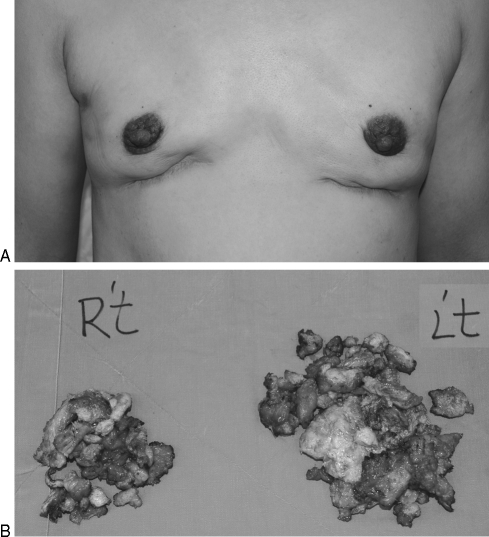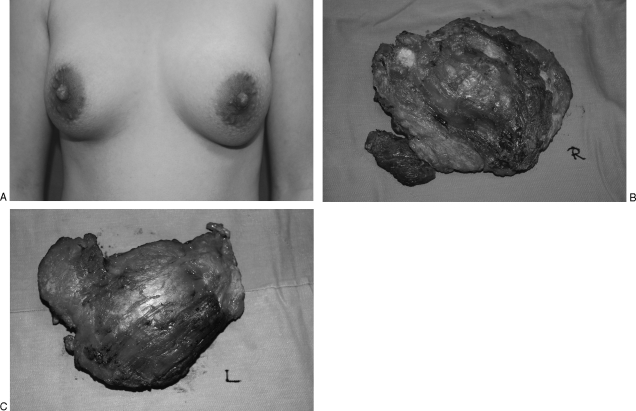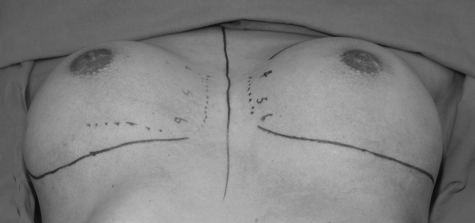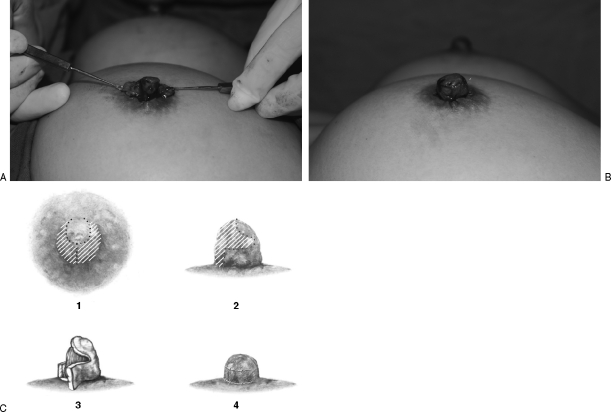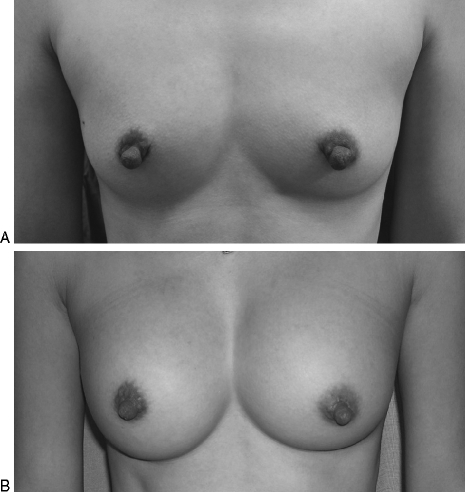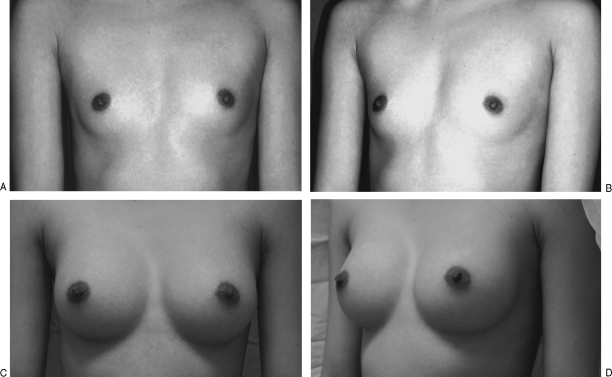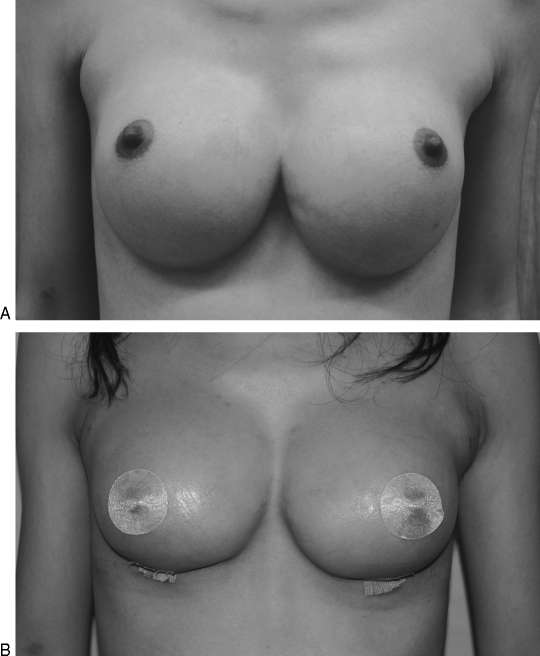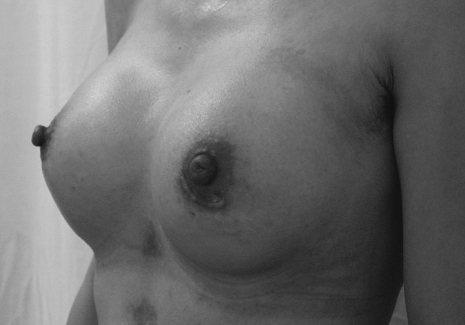ABSTRACT
With the rapid economic development of Southeast Asia, the demand for cosmetic surgery has increased rapidly. Breast augmentation is among the most frequently performed cosmetic procedures. However, breast augmentation still has “bad press” in Southeast Asia because of not so distant catastrophes caused by direct liquid silicone injection and “Amazing Gel” augmentations. Asian patients have special characteristics that need to be taken into consideration when performing breast augmentation. The patients are usually thin and small with proportionally smaller breasts. The areola is often small with a large nipple. Because of poor scar healing, incisions need to be hidden. The transaxillary approach is therefore favored. A frequently performed adjunctive procedure is nipple reduction. In this article, the authors present their preferred technique for augmentation mammaplasty: endoscopically assisted subpectoral placement of smooth saline-filled implants via a transaxillary approach. Simultaneously, nipple reduction with the “modified top-hat flap” procedure is presented. Complications and their management are also discussed.
Keywords: Breast augmentation, Asian, endoscopically assisted, aesthetic surgery
Augmentation mammaplasty is a procedure for enhancing breast size and shape. Indications include small breast, loss of breast volume after body weight loss, or sagging breast due to aging. Augmentation mammaplasty has become one of the most popular aesthetic procedures in the world. From the Web site of the American Society of Plastic Surgeons, augmentation mammaplasty procedures have increased 55% from 2000 to 2006 in the United States.1 With rapid economic development in Southeast Asia, breast augmentation and other cosmetic surgeries are increasingly performed. However; there is little information focusing on the particularities of augmentation mammaplasty in Asian women.
The purpose of this article is to recall the history of breast augmentation in Asia, discuss the particularities of the Asian breast, and present the authors' technique for breast augmentation and nipple reduction. Complications and their management will be discussed as well.
BACKGROUND
A Brief History of Breast Augmentation Techniques and Materials in Taiwan and China
Liquid silicone injection made directly into the breast mound had been very popular during past decades, mostly in China and Taiwan. Most of the injections are performed illegally in beauty salons by laypersons. Complications after liquid silicone injection are frequent. They include siliconoma, foreign body reaction, cysts, abscesses, skin rashes, ulcerations, and deformed breasts (Fig. 1A, B). The treatment of such complications remains a challenge for plastic surgeons.2 Hopefully, continuing public education in Taiwan and China will decrease the use of this illegal technique for breast augmentation.
Figure 1.
Complication of liquid silicone injections. (A) Preoperative picture presenting a patient with bilateral severe breast deformations secondary to injection of liquid silicone. Siliconomas have been removed partially at another hospital via an IMF approach. (B) Excised siliconomas.
“Amazing Gel,” also known as “Ao Mei Ding,” is another illegal product injected directly into breast tissues. This polyacrylamide hydrogel was introduced in China3,4 for breast augmentation around 1997 and was mainly used in China. Its injection by some doctors and hair-salon employees was tolerated. It is estimated that more than 500,000 people have been injected with Amazing Gel. Complications were numerous and include breast tissue damage and even pectoralis major infiltration (Fig. 2A, B, C). China finally banned the use of Amazing Gel in April 2006 after 9 years of its tolerated use.3,4
Figure 2.
Complication from Amazing Gel injections. (A) Note bilateral breast distortion secondary to a foreign body reaction to the Amazing Gel (polyacrylamide hydrogel). (B, C) Foreign body removed en bloc from right and left breasts. Breast tissue as well as muscle had to be removed.
Silicone breast implants were introduced in Asia shortly after their introduction in the United States. They have been banned in Taiwan since 1992 after the well-known controversies surrounding their health consequences. They have not been reintroduced despite the U.S. FDA reapproval in November 2006. However, they are legal in China.
Cohesive silicone implants made by Mentor (Santa Barbara, CA) and McGhan (Costa Rica) are commonly used. Cohesive implant availability has never been interrupted in Japan, Korea, China, and Southeast Asia since their market availability. There are also some locally made implants with different materials, such as silicone or saline, available in China (Guangzhou Wanhe Plastic Materials Co., Guang-zhou, China; and Kangning Medical Sevice Co., Shang-hai, China).
Characteristics of Asian Breasts
Asian women are usually short and slim with a low body mass index compared with Westerners and African Americans. Asian women usually have small breasts with small areolas and large nipples. The majority of Asian women have B-sized cups. Some women are more close to A-cups.
Most women consider C-cup breasts as the ideal size when they are contemplating undergoing augmentation mammaplasty. Theoretically, the demand of augmentation mammaplasty would be huge. However, the number of augmentation mammaplasties performed in Asian women is not as high as it would be expected in Western culture.
An exaggeratedly enlarged, round-shaped nipple with a small areola is a deformity frequently observed in Asians, especially after childbirth. When a patient presents such a deformity, she frequently request to get it corrected at the same time as she has breast augmentation.5,6
AUGMENTATION MAMMAPLASTY PROCEDURES
There are many choices to make before performing a breast augmentation: skin incision, tissue plane placement of the implant, implant type (saline, silicone, cohesive gel), implant manufacturer and model, and characteristics of the implant (projection, base diameter, “anatomic” versus round, textured versus smooth). In general, Asian women prefer a transaxillary approach with high-profile saline-filled implants placed in a submuscular plane. The average breast augmentation in Asians is around 300 cc. Most plastic surgeons use a traditional blunt dissection through an axillary incision rather than using an endoscope. Cohesive silicone implants are the most popular implant type in Asia.
When considering the surgical approach, one should take into account the fact that Asians have a tendency to produce hypertrophic scars. The scar itself often becomes temporarily hyperpigmented as does surrounding skin for a period of time. Incisions in the inframammary fold are therefore less favored as they can remain visible for quite a long time.
SURGICAL TECHNIQUES
Submuscular Breast Augmentation Via an Axillary Incision
The patient is placed under general anesthesia in the supine position with both arms in abduction. Axillary hair is shaved. Disinfection is performed from the neck to the umbilicus inferiorly and to the elbows laterally. Two video monitors are placed on each side of the operating table, one for the surgeon and the other for the assistant.
A 3-cm skin incision is made in the axillary fold. The axillary incision needs to be lengthened to 5 cm if the surgeon plans to use cohesive gel implants. Dissection proceeds through Scarpa's fascia until the lateral edge of the pectoralis muscle is reached. The plane between the pectoralis major and minor is identified. A Nagumo dissector (designed by Dr. Yoshinori Nagumo) is inserted to facilitate dissection. The pectoralis minor is separated from the pectoralis major muscle according to different muscle fiber directions.
An oval spatulated blade (ASSI, Westbury, NY) is inserted to gently free the pectoralis major, especial in the upper pole of the pocket, up to the clavicle. A Byrd EndoPlastic Retractor (Snowden Pencer, Tucker, GA) is used to allow the insertion of a 5-mm, 30-degree fiberoptic endoscope (Storz and Co., Tuttlingen, Germany). An endoscopic electrocautery is used to split the origins of the pectoralis major from the fourth to the sixth rib. The two lower breast quadrants are completely freed from the 3 o'clock to 9 o'clock positions. Figure 3 shows the area of pocket dissection.
Figure 3.
Endoscopic pocket dissection area. The origins of pectoralis major at the fourth, fifth, and sixth ribs are released. The inferior quadrants of the breast are freed from the 3 o'clock to 9 o'clock positions.
Mammary sizers are inserted in the pockets and inflated with air. The patient then sits up. An adequate inflation volume is chosen: 270 to 330 cc is usually necessary to achieve a C-cup breast mound. Pocket dissections are corrected if necessary to obtain symmetry. Sizers are removed and pockets are irrigated with peroxide to ensure hemostasis.
Saline-filled implants are inserted in the pocket and filled to the previously determined volume. The wound is approximated in two layers. No drains are used. Fluff is placed around the breast mound.
The patient usually returns home the same day. Oral antibiotics are prescribed for 3 days. Activities are not restricted. The patient may resume sports after 2 weeks. Massages are started at postoperative day 3 and performed three times daily for 3 months.
Nipple Reduction
This procedure is usually performed when the implants are in place. The technique used by the authors is the “modified top-hat flap” technique (Fig. 4A, B)6 It can decrease both diameter and height of a hypertrophic nipple without damaging nipple sensation and circulation. This procedure is a frequent adjunct to breast augmentation (Fig. 5A, B).
Figure 4.
Modified top-hat flap technique. (A) The incision done for the modified top-hat flap. (B) Nipple reduction after closure. (C) 1 and 2: The incision line of the modified top-hat flap for nipple reduction. 3: The modified top-hat flap elevated. 4: The shape of the nipple after reduction.
Figure 5.
Breast augmentation with simultaneous nipple reduction with the modified top-hat flap technique. (A) Preoperative view. (B) Follow-up at 15 months.
DISCUSSION
This procedure results in natural-looking breasts with a smooth and quick postoperative recovery (Fig. 6A, B, C, D). Subglandular augmentation mammaplasty via an inframammary incision is popular in Western countries.7 However, leaving a hypertrophic scar at the lower pole of the breast is generally not accepted by most Asia women. An inframammary approach is used in selected cases such as for siliconoma removal and release of severe capsular contracture (Fig. 7A, B). A hypertrophic hypopigmented scar resulting from periareolar or transareolar incisions can also be disturbing8 (Fig. 8).
Figure 6.
A 28-year-old, thin woman with hypoplasic breasts. (A) Preoperative anteroposterior view. (B) Preoperative oblique view. (C) Postoperative anteroposterior view at 3 months. The augmented breast mounds look natural and pleasing. (D) Postoperative oblique view.
Figure 7.
Use of the inframammary approach for correction of complication and secondary deformities. (A) A 25-year-old patient presenting with bilateral inferior displacement of implants, symmastia, and capsular contractures. Displacement of the implants and symmastia was thought to be due to inappropriate massaging. (B) Thirty-five days postoperatively. An inframammary approach was used to correct the deformities and release the capsular contracture. A new inframammary fold was created by fixing the dermis to the rib cage.
Figure 8.
A hypertrophic, hypopigmented scar after a periareolar incision in this Asian patient.
Transaxillary approach places the scar at a distance from the breast in an inconspicuous location. It also allows easy placement of the implant in the submuscular plane. This causes less capsular contracture and implant palpability, less sensory disturbances in the nipple-areolar complex, and better breast lesion detection by sonography or mammography.9 At our institution, submuscular augmentation through an axillary incision is the favorite approach.
The classic transaxillary approach with blind submuscular dissection had some disadvantages including poor visualization, inaccurate pocket dissection, and poor bleeding control. With the advent of endoscopic transaxillary augmentation, these are no longer problematic.9,10,11 This minimally invasive technique allows more accurate pocket dissection with precise placement of the implant under the pectoralis muscle. There is less intraoperative bleeding and less postoperative pain than with blunt dissection.11 Use of the endoscope also allows breast augmentation through previous unrelated scars around the breast mound without the absolute need to go through one of the classic skin incisions.12
COMPLICATIONS AND THEIR MANAGEMENT
The most common complication after breast augmentation in Asians is capsular contracture. Postoperative massage is very important to decrease capsular contractures and preventing high-riding implants. Established capsular contractures of Baker grade 3 to 4 need to be managed surgically. A capsulotomy can be performed with the endoscope through the previous transaxillary incision after taking the saline-filled implants out. Alternatively, an inframammary incision can be used. Breast distortion can also be caused by inadequate release of the pectoralis major's origin or by dissecting breast pockets that are too small.
After implantation for a period of time, the weak rectus abdominis fascia may not be adequate to support the implant. Inframammary fold malposition can occur. A low-riding implant has to be repositioned after opening up the upper capsule creating a new inframammary fold by fixation of the dermis to the costal periosteum. Other causes of asymmetric inframammary folds include unrecognized preoperative asymmetry or anterior thoracic hypoplasia.13,14,15 Preoperative diagnosis and discussion with the patient about realistically obtainable results are necessary.
CONCLUSION
Asian patients are usually thin and small with proportionally smaller breasts. A small areola with a large spherical nipple is frequent, mostly after pregnancy. The endoscopically assisted subpectoral placement of smooth saline-filled implants via a transaxillary approach is favored in Asians. Simultaneously, nipple reduction with the modified top-hat flap procedure can be performed simultaneously for a better outcome.
REFERENCES
- American Society of Plastic Surgeons 2000/2005/2006 National Plastic Surgery Statistics, Cosmetic and Reconstructive Procedure Trends. Available at: http://www.plasticsurgery.org/media/statistics/loader.cfm?url=/commonspot/security/getfile.cfm&PageID=23628. Accessed December 8, 2008. Available at: http://www.plasticsurgery.org/media/statistics/loader.cfm?url=/commonspot/security/getfile.cfm&PageID=23628
- Mizuno H, Hyakusoku H, Fujimoto M, Kawahara S, Aoki R. Simultaneous bilateral breast reconstruction with autologous tissue transfer after the removal of injectable artificial materials: a 12-year experience. Plast Reconstr Surg. 2005;116:450–458. doi: 10.1097/01.prs.0000172897.41951.bc. [DOI] [PubMed] [Google Scholar]
- UPI Amazing gel woes may be “enormous.” The Post Chronicle 2006;May 31. Available at: http://www.physorg.com/news68374349.html. Accessed December 8, 2008. Available at: http://www.physorg.com/news68374349.html
- Macarthney J. Thousands maimed by “miracle” implants gel. Times of London, 2006;May 31. Available at: http://www.timesonline.co.uk/tol/news/world/asia/article669884.ece. Accessed December 8, 2008. Available at: http://www.timesonline.co.uk/tol/news/world/asia/article669884.ece
- Baxter R A. Nipple or areolar reduction with simultaneous breast augmentation. Plast Reconstr Surg. 2003;112:1918–1921. doi: 10.1097/01.PRS.0000091421.10546.8F. [DOI] [PubMed] [Google Scholar]
- Cheng M H, Smartt J M, Rodriguez E D, Ulusal B G. Nipple reduction using the modified top hat flap. Plast Reconstr Surg. 2006;118:1517–1525. doi: 10.1097/01.prs.0000240815.10945.7f. [DOI] [PubMed] [Google Scholar]
- Sevin A, Sevin K, Senen D, Deren O, Adanali G, Erdogan B. Augmentation mammaplasty: retrospective analysis of 210 cases. Aesthetic Plast Surg. 2006;30:651–654. doi: 10.1007/s00266-006-0076-x. [DOI] [PubMed] [Google Scholar]
- Lee E J, Jung S G, Cho B C, Kim Y B. Submuscular augmentation mammaplasty using a perinipple incision. Ann Plast Surg. 2004;52:297–302. doi: 10.1097/01.sap.0000106887.49177.66. [DOI] [PubMed] [Google Scholar]
- Price C I, Eaves F F, III, Nahai F, Jones G, Bostwick J., III Endoscopic transaxillary subpectoral breast augmentation. Plast Reconstr Surg. 1994;94:612–619. doi: 10.1097/00006534-199410000-00007. [DOI] [PubMed] [Google Scholar]
- Ho L C. Endoscopic assisted transxillary augmentation mammaplasty. Br J Plast Surg. 1993;46:332–336. doi: 10.1016/0007-1226(93)90015-4. [DOI] [PubMed] [Google Scholar]
- Momeni A, Padron N T, Föhn M, et al. Safety, complications, and satisfaction of patients undergoing submuscular breast augmentation via the inframammary and endoscopic transaxillary approach. Aesthetic Plast Surg. 2005;29:558–564. doi: 10.1007/s00266-005-0095-z. [DOI] [PubMed] [Google Scholar]
- Ulusal B G, Cheng M H, Wei F C. Simultaneous endoscope-assisted contralateral breast augmentation with implants in patients undergoing postmastectomy breast reconstruction with abdominal flaps. Plast Reconstr Surg. 2006;118:1293–1302. doi: 10.1097/01.prs.0000239460.94909.4d. [DOI] [PubMed] [Google Scholar]
- Codner M A, Cohen A T, Hester R. Complications in breast augmentation: prevention and correction. Clin Plast Surg. 2001;28:587–595. [PubMed] [Google Scholar]
- Hodgkinson D J. The management of anterior chest wall deformity in patients presenting for breast augmentation. Plast Reconstr Surg. 2002;109:1714–1723. doi: 10.1097/00006534-200204150-00039. [DOI] [PubMed] [Google Scholar]
- Spear S L, Pelletiere C V, Lee E S, Grotting J C. Anterior thoracic hypoplasia: a separate entity from Poland syndrome. Plast Reconstr Surg. 2004;113:69–77. doi: 10.1097/01.PRS.0000090727.07735.F5. [DOI] [PubMed] [Google Scholar]



